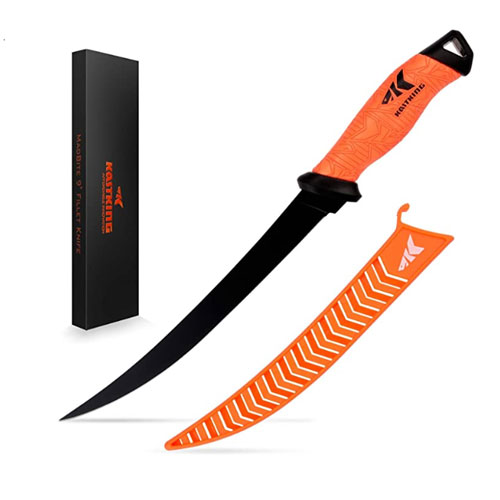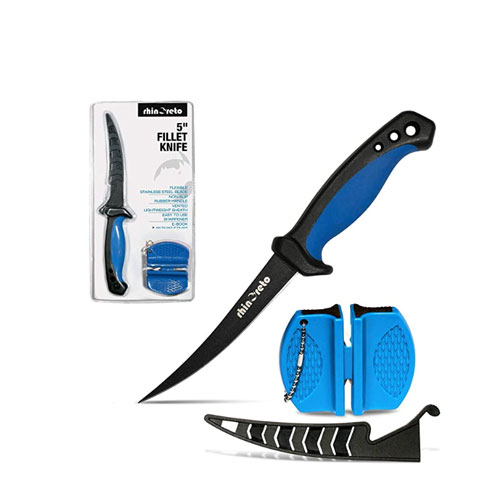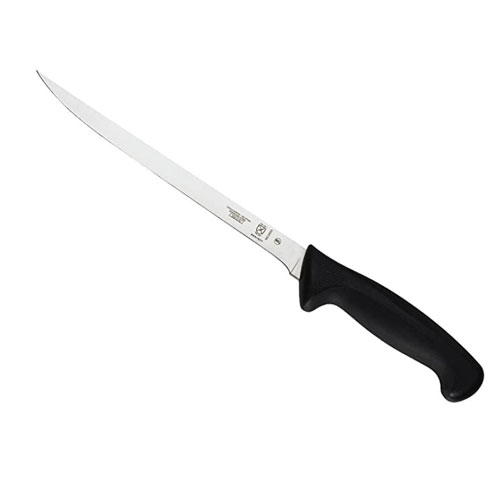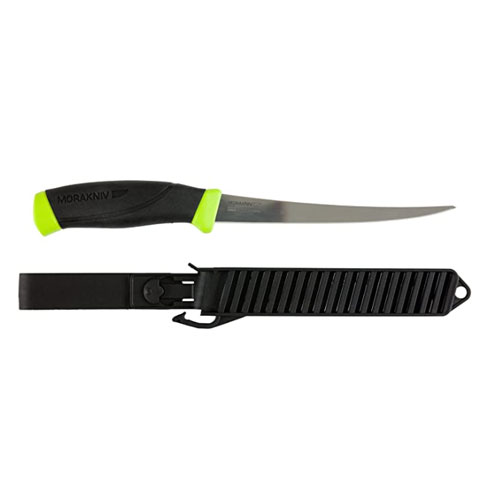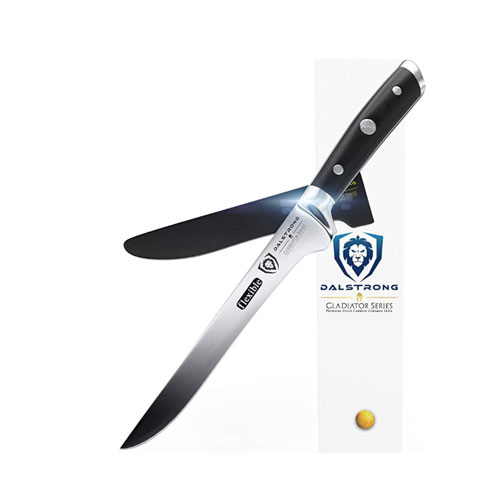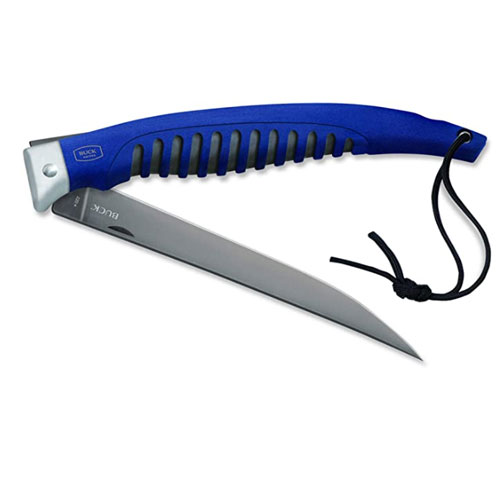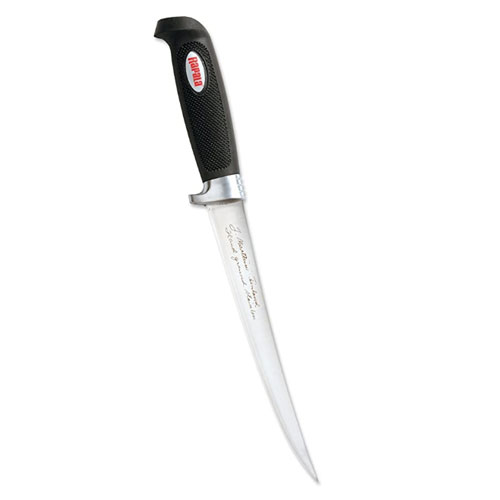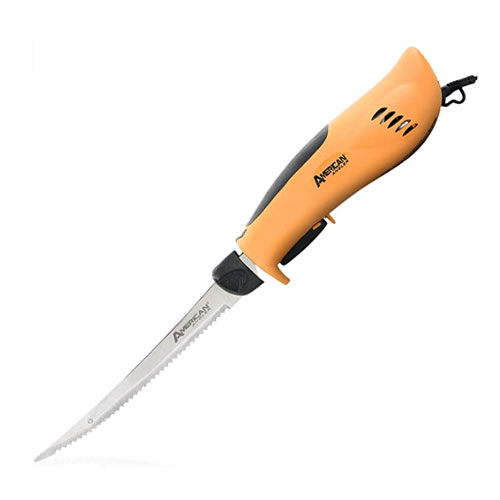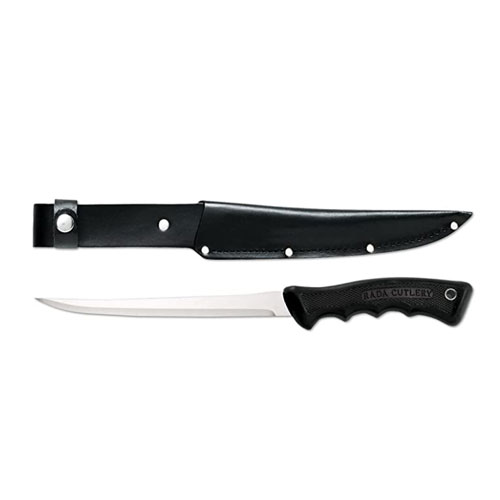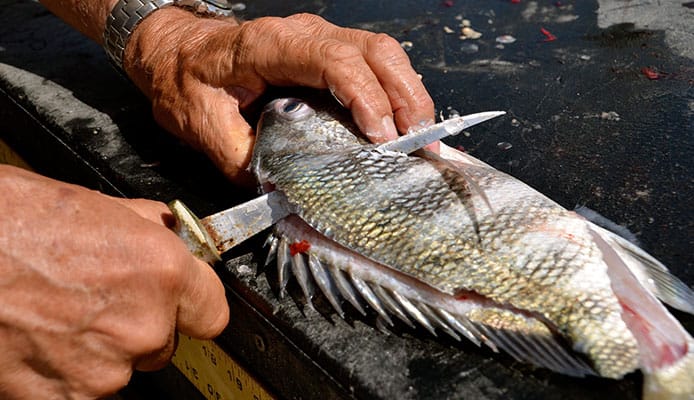
-
1.
-
2.
-
3.
-
4.
-
5.
It takes the right tool to do a job well. When it comes to preparing fish, a quality fish cleaning knife is the right tool. The best fish fillet knives offer the control, flexibility, and sharpness needed to make cuts precisely.
A good fillet knife is like an extension of your hand making you precise and delivering great fillets you’re proud to present. In the fish fillet knife reviews below, we have singled out the 10 best fillet knives most adept at filleting fish.
OUR TOP PICK
KastKing 9 Inch Professional Level
- Stand Out Features - Why We Love It
- Super-sharp German steel blade with incredible edge retention
- Versatile blade with the ideal amounts of flex and backbone
- Comfortable handle with a non-slip grip
- Locking knife sheath keep the blade secure
Blade Size: 6, 7, and 9 inch
Blade: G4116 German Stainless Steel
Handle: Polymer
EDITORS CHOICE
Rhinoreto Ergonomic
- Stand Out Features - Why We Love It
- Flexible, curved, and smooth blade cuts through fish easily
- Ergonomic handle for both left and right-handed users
- Corrosion-resistant blade for freshwater and saltwater fish
- Safety guard extends 360 degrees around the handle
- Package includes a protective sheath and sharpener tool
Blade Size: 5 and 8 inch
Blade: Stainless Steel
Handle: Rubber
BEST VALUE
Mercer Culinary Millennia Ergonomic
- Stand Out Features - Why We Love It
- Blade made of high-carbon Japanese stainless steel
- Ergonomic handle with textured finger grips
- Razor sharp right out of the box and easy to sharpen
- Great strength and sufficient flex for large fish filleting
- Top-notch quality and performance at a great price
- Meets NSF standards for safety, quality, and performance
Blade Size: 8.5 inches
Blade Material: High Carbon Stainless Steel
Handle Material: Santoprene and Polypropylene
Victorinox Swiss Army 6 Inch Fibrox Pro Boning
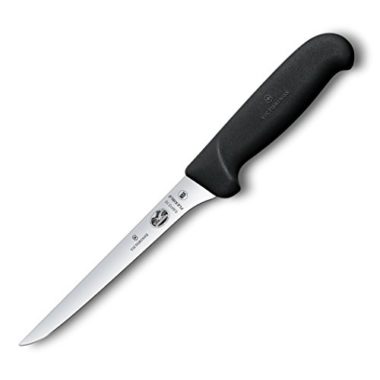
- Stand Out Features - Why We Love It
- Super-sharp blade holds its edge well and sharpens easily
- Ergonomic handle reduces hand and wrist fatigue
- S-shaped and flexible blade is ideal for filleting fish
- Non-slip Fibrox Pro handle for a secure grip
- Meets the NSF standards for public health protection
- Trusted Swiss quality backed by a lifetime guarantee
Blade Size: 6 Inches
Blade Material: High Carbon Stainless Steel
Handle Material: Fibrox
Morakniv Fishing Comfort
- Stand Out Features - Why We Love It
- Made in Sweden and backed by a lifetime warranty
- Sandvik blade is razor-sharp, tough, and has superior corrosion resistance
- Patterned high-friction grip provides a sure grip even when wet
- Slotted and odor-resistant plastic sheath with two belt clips
- Polymer edge protection is easy to keep clean
Blade Length: 6.1 inches
Blade Material: Cold Rolled Sandvik Stainless Steel
Handle Material: TPE Handle
DALSTRONG Gladiator Series Boning
- Stand Out Features - Why We Love It
- Gorgeous high carbon stainless steel blade with a satin finish
- Tapered design for flexibility and hardness
- Luxurious Pakkawood ergonomic and ambidextrous handle
- Polished spine for a comfortable pinch grip
- Full tang and triple-riveted for robustness and durability
- BPA-free protective sheath included
Blade Size: 6 inches
Blade Material: German High-Carbon Steel
Handle Material: Pakkawood
Buck 0220BLS Knives Silver Creek Folding
- Stand Out Features - Why We Love It
- Foldable to half its size for ease of storage and transportation
- Comfortable TPE rubber coated handle with a non-slip grip
- Medium blade length and flex for handling a variety of fish
- Extremely sharp blade with excellent edge retention
- 420J2 steel blade coated with titanium for enhanced durability
- Durable construction backed by a lifetime guarantee
Blade Size: 6-1/2 inches
Blade Material: 420J2 Stainless Steel with Titanium coating
Handle Material: Polypropylene with a TPE Rubber coating
Rapala4 Soft Grip Fish
- Stand Out Features - Why We Love It
- Razor-sharp and flexible yet strong blade
- Ergonomic handle with a no-slip grip for maximum control
- Protective finger guard for safety and hygiene
- A variety of blade sizes to choose from
- Package includes a sheath and single stage sharpener
Blade Sizes: 4, 6, 7.5 and 9 inches
Blade Material: Stainless Steel
Handle Material: Thermoplastic
American Angler PRO Professional Grade Electric
- Stand Out Features - Why We Love It
- Powerful electric fillet knife with a lot of torque (110 Volt)
- Long and strong blade for handling big saltwater fish species
- Makes large and bulk filleting jobs easy and quick
- Interchangeable blade design allows you to use different blades
- Corrosion-resistant blade for cleaning saltwater species
- Durable construction backed by a 2-year warranty
Blade Size: 8.5 inches
Motor: 110 Volt
Blade Material: Stainless Steel
Rada Stainless Steel Blade
- Stand Out Features - Why We Love It
- Flexible and versatile blade for a wide range of fish sizes
- Soft rubber grip and ergonomic handle design
- Durable construction and a hassle-free lifetime guarantee
- Corrosion-resistant blade made of surgical-grade steel
- Comes with its own custom leather scabbard
Blade Size: 7-1/8 inches
Blade Material: T420 High Carbon Stainless Steel
Handle Material: Rubber
How To Choose A Fish Fillet Knife – Buying Guide
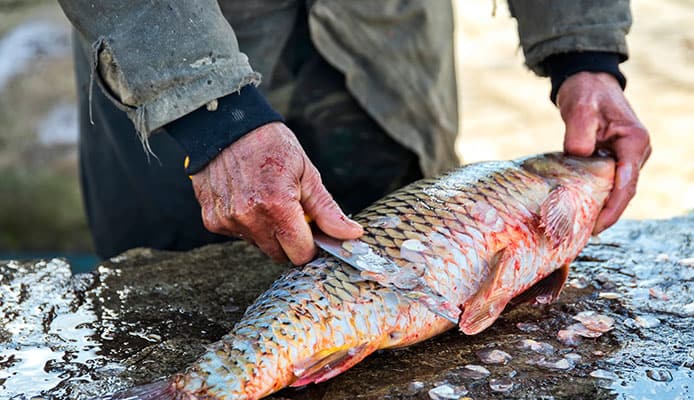
Blade and Handle Material
The best fish cleaning knives have stainless steel blades. What makes it a great fillet knife material is its strength, and rust, corrosion, and stain resistance. It handles water, blood, and scales well, and sharpens easily. The best fish fillet knife made of high carbon stainless steel is especially easy to sharpen.
Fish filleting knife handles are usually made of wood, rubber, or plastic. Rubber offers the best fish fillet knife grip even in wet and slippery conditions. Wooden handles look good and are comfortable to use. However, wood easily gets slippery, absorbs odors, and continued exposure to water can cause it to rot. Plastic is hard-wearing and doesn’t retain odors.
Safety and Hygiene
With its razor-sharp blade and constant contact with bacteria, a fish flaying knife is a dangerous tool. It should be designed in a way that promotes safe and sanitary handling. Finger grooves and a protective finger guard at the point where the blade meets the handle helps protect fingers from slipping.
When it comes to hygiene, a good fillet knife should have the handle molded in place and sealed so there’s no gap for the flesh, blood, and slime to accumulate and become a breeding ground for bacteria.
Type and Design
For preparing large fish, bulk filleting, or for handling a variety of fish when indoors, consider an electric fillet knife. It’s fast, requires little effort on your part, and you can swap blades. This makes it the best fish fillet knife for saltwater fish. For outdoor use, a manual fillet knife for fish is great because it doesn’t require a power source.
A straight-edge blade is great for filleting as it makes precise cuts and clean slices. A fillet knife fish with a serrated blade is a good option for piercing through tough scales. The handle should have an ergonomic design that fits well in the hands. A full tang makes a knife robust and offers greater control and leverage.
You might also like: Perfect Fish Scalers
Blade Size
A good guideline is to choose a blade that’s just slightly longer than the depth of your target fish at its widest point. This will ensure that only one pass is needed to fillet and the result will be a clean and solid fillet. You will come across 4 inch, 6 inch, 7.5 inch, and 9 inch long blades.
Shorter 4-5inch long blades work best for small-sized fish such as bluegills, crappie, panfish or walleye. A medium blade of 6-7.5inch length makes for a good all-purpose fillet knife great for lakes and river fishing and medium-sized fish such as trout. Larger fish such as tuna, salmon, and steelhead require larger sized blades with an 8-9inch blade length.
Grip and Handling
When preparing fish, your hands will be wet and even slippery. The best fish fillet knife offers a firm, non-slip grip no matter the conditions. The handle should be sturdy and comfortable to hold. A strong grip offers better control and leverage, which makes it easier to maneuver through the fish and achieve precision. Features to look for including a slip-resistant texture and finger grooves.
Flexibility
Filleting fish precisely requires flexibility to maneuver between flesh and bones. Long and thin blades flex easily and this is why the best fillet knives for fish have such blades. Shorter and thinner blades offer a lot of flexibility for cleaning small fish and removing bones. Larger, longer, and thicker blades offer less flexibility but more stiffness for larger and tougher cutting jobs.
Sharpness
The blade is the most important part of a knife for filleting fish. It should be super-sharp so it slices right through the fish making clean cuts without tearing or jagging. The best fillet knives come razor-sharp and hold their edge well. It’s also important to hone your knife for fish fillet on a regular basis. Without routine upkeep, even the sharpest fillet knife blades will lose their edge.
FAQs
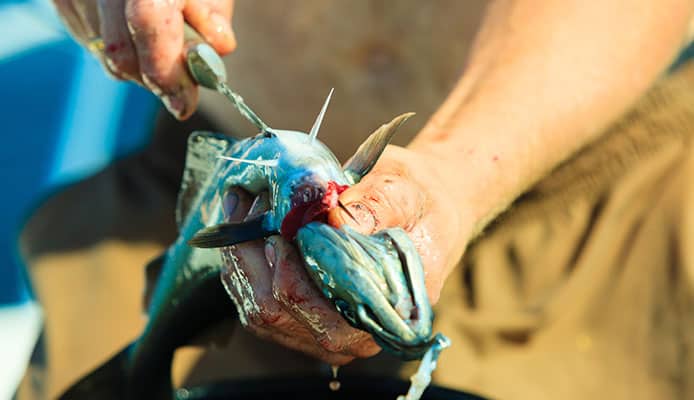
Q: When Is A Fillet Knife Necessary?
A fillet knife is necessary for extracting the meat from the bones. A fish flaying knife comes handy whenever you need to prepare, descale, skin, or fillet fish. It offers the flexibility you need to easily maneuver through the flesh and separate the meat from the bones, scales, and skin with great precision. A good fillet knife easily becomes the go-to knife for all kinds of cutting tasks.
Q: How Does A Fillet Knife Differ From Other Knives?
A fillet knife is specially designed for separating meat from bones. A fish cleaning knife is an even more specialized knife for filleting fish. Fish fillet knives usually feature a thin heavily tapered blade with pointed ends and have a lighter feel than other knives. This design enables them to maneuver through the delicate flesh of fish.
Q: What Is Considered Good Material?
Stainless steel is the best material for the blade. It’s strong yet flexible, and resistant to rust, corrosion, stains, and odors. It’s also easy to sharpen and retains the edge well. For the handle, a good material should offer a comfortable yet strong grip and be easy to clean. Wood, rubber, and plastic are all good handle materials.
Q: Is It Safe To Put A Fillet Knife In The Dishwasher?
Throwing fillet knives in the dishwasher is not a good idea. The intense heat and harsh detergents will cause the handle and adhesive to deteriorate gradually. Colliding with other dishes can also dull the blade’s edge. Even though the knife label may say ‘dishwater safe’, we recommend hand washing fillet knives to preserve the edges and make them last longer in tiptop condition.
Q: Why Is The Handle Important?
The handle of a fillet knife is very important because it determines how well you can fillet using the knife. The handle determines the kind of grip, control and leverage you have for maneuvering through the flesh and executing the cut. For the best filleting experience, the handle should be sturdy, comfortable, and offer non-slip grip even in wet conditions.
Globo Surf Overview
If you want to prepare nice fillets, a good fish cleaning knife is vital. Hopefully, our reviews of the best fillet knives will help you find the best fillet knife for your needs. With a good fish flaying knife, filleting fish will be a breeze. A good quality fish cleaning knife also comes handy for all kinds of cutting tasks when fishing or preparing food.
More Knife Reviews:
Which is the best fillet knife? We would love to hear about your filleting knife experience! Share in the comment box below.



